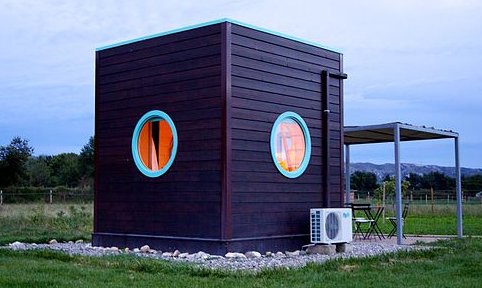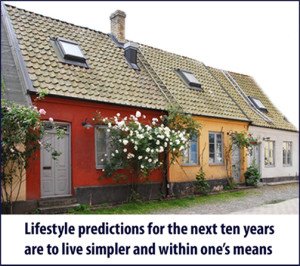July 16, 2013 | Posted in Tiny Houses | By Joanne
Tiny And Small Houses Can Be Found All Around Europe
 The tiny house movement is making its way around the world, and tiny houses in Europe has started to make its mark. The recent housing bubble burst and the desire to go “green”, are among the reasons European home buyers are looking to go small.
The tiny house movement is making its way around the world, and tiny houses in Europe has started to make its mark. The recent housing bubble burst and the desire to go “green”, are among the reasons European home buyers are looking to go small.
As this type of housing is just starting to become popular in Europe, there aren’t a lot of companies building them. I’ve only found two sources so far:
and
The homes built in Europe are already much smaller than those built in countries like Australia and the US. How much smaller can they get? With the average size house being built in the UK at about 15.8 square meters, or 30 square meters in France, it seems that Europeans have already gone small. But there are other areas of Europe that are just now beginning to embrace the tiny lifestyle.
Economic Downturn
As with the US, many parts of Europe have recently been facing an economic downturn that has caused issues in the housing market. European homes prices were had increased substantially before the economic crisis, and then dropped more after the housing bubble burst than they did in the US. Many people can’t find housing, or can’t afford the housing that is available. Many of those people are looking to other alternatives.
For some, they have started to look towards very small houses; hence Tiny Houses Europe becomes more and more popular. They have found that these smaller homes have a much smaller price tag and can give them everything they need.
Designing with Tiny in Mind
Depending on what you need from your tiny home, the design of your house will be critical. Using every inch of space becomes more important the lower the square footage in your home.
You could have your little house plans designed by an architect who specializes in smaller spaces. They will be able to recommend a great design that will best fit all of your needs using less square footage.
Using design ideas like lofts, drop down tables and toilet/shower combos are great ways to get the most out of your small space.
The furniture used inside a tiny home is as important as the design of the home itself. Using furniture that can serve multiple purposes, like a pull out bed will be ideal in the design of the inside of your home.
Uses for Tiny Homes
Also referred to as a “micro home”, these small homes can serve many functions. Not everyone can on a full-time basis. They work well when placed in the back yard as a guest house or even a separate space for a student still living at home but desiring their own home to call their own. They also are ideal for an elderly parent who you want living close by that still prefers a private living quarters.
These smaller, less costly homes are ideal if you often travel to a specific location for work. One of these small homes will save you money over the cost of hotel or apartment rental during your short but frequent visits. Or for those who need a weekend getaway, you could build one in the country and use it as a vacation home.
Whether you want to hire someone to build your tiny house or build one yourself, you can be sure to get just want you want out of your design. You can build your house from the ground up, or you can buy kits that allow you to put the pieces together.
Green Houses
A popular trend these days, whether building a house big or small, is building environmentally friendly houses. Using recycled materials, solar panels, compost toilets among many other “green” options is a great way to minimize your ecological footprint.
Benefits of Living Small
 Most people that move into a smaller home do so to free themselves from the much larger mortgage payment that comes with owning a bigger home. Some are even able to pay cash so there is no mortgage to weigh you down. Sometimes you can find a previously lived in tiny home for $10,000 or less. When it comes to building one yourself, you will find that many can be built new for under $20,000.
Most people that move into a smaller home do so to free themselves from the much larger mortgage payment that comes with owning a bigger home. Some are even able to pay cash so there is no mortgage to weigh you down. Sometimes you can find a previously lived in tiny home for $10,000 or less. When it comes to building one yourself, you will find that many can be built new for under $20,000.
Whether you choose to build your home “green” or not, your small home will leave a smaller ecological footprint simply because it is smaller. The reason being is that there will be less energy needed and fewer materials needed to build the home.
Less square footage means less cleaning. For example, less floor space means that you would use less time and energy to mop and vacuum.
Limited space to store items will mean you will end up with fewer things in your home. You will have no choice but to keep your tiny space free from clutter if you want room to sit down and room to get around.
Maintenance costs for a house with less square footage will naturally cost much less than a house with more square footage. Your tiny residence will use less paint when it needs to be refreshed and less carpet or flooring when it requires replacement. Fewer supplies will mean less money, more savings, and more for you to do what you really prefer.
Energy costs will be considerably less for a smaller home. You will find they are cut drastically when you cut the size of your home in half or more. This is a huge benefit of living tiny.
Due to the housing crisis that has recently impacted parts of Europe, and the desire for many to “go green” or at least go smaller, tiny houses Europe has started to grow in popularity. Europeans are realizing that they can get everything they want from a small house with a small price tag.


